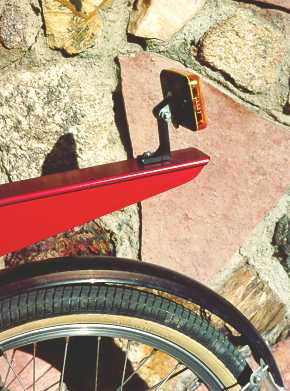The BikeE is a simple, cleanly-designed compact long wheelbase recumbent bicycle. It's fun and quick, and is one of the most popular recumbents presently available for sale. Here are some ideas I've gathered from riding one since October of 1996. If you have any ideas for additions to this list, please let me know by sending me email at wblock@wonkity.com.
Start out riding in gears that seem lower than necessary. Because you
can push against the seat back for more power, there's a temptation to
use gears that are higher than appropriate. This can cause ankle and knee
pain, so resist the urge, and keep a higher cadence at lower gears. You'll
go just as fast with less strain.

PowerGrip straps or clipless pedals are easier to use on the BikeE than toeclips, which hang at an angle that makes it difficult to get feet into them.
Removing the chainguard tube makes for a quieter and possibly more efficient drivetrain. If you use a "dry" or "hard" chain lubricant, or just wipe all the oil off the outside of the chain after oiling it, your pants or leg won't get chain marks.
With a Craig Superlink chain link, it's possible to remove the chain without tools, making it much easier to clean.
Fenders are well worth having, especially for the front wheel, where they'll keep dirt and mud from being flung up on you. Mud flaps can be cut from plastic milk jugs or old inner tubes. With the bottom of the mud flap within one inch of the ground on the front fender, nothing will make it past to splash on you.
The Avid Rollamajig can greatly improve rear derailer shifting. This pulley eliminates the drag of the loop of cable in the rear housing. A good minimum length for the rear derailer cable housing is about 7-1/2 inches, but start with it longer than that.
Other things to check for poor shifting: grit in the rear cable housing, cable off its track on the roller inside the beam, cable housing that runs down the stem shifted far to one side or compressed by a zip tie.
The axle on the Sachs 3x7 hub is 11mm in diameter, 1mm larger than a standard axle. This causes problems when trying to use a Park FR-5 freewheel tool to remove the lockring on the Hyperglide cassette. The solution is simple: slightly enlarge the hole in the FR-5. This can be done with a round file or electric drill.
The rear fork may develop a squeak when it flexes and rubs against the main beam. As suggested by BikeE's Lee Eckroth, adding a drop of Phil Wood Tenacious Oil to the squeaking area between the aluminum beam and the steel rear fork will silence it.
Want lower gears? The guard disk on the cranks can be replaced with another, smaller chainring. The 130mm bolt circle diameter means that the smallest ring available has 38 teeth, but a 39-tooth might allow a little better chain clearance on the bolts. Of course, there's no front derailer, but it's easy to stop and quickly lift the chain from one ring to the other.
When the Sachs 3x7 hub cable has been properly adjusted, reconnecting it after a wheel removal and reinstallation is easy: set the shifter to "1" and push the threaded rod into the plastic quick-release doohickey until the indicator chain is pulled as far out of the hub as possible. You may need to spin the wheel backward slightly to get the hub to release the full length of indicator chain.
It's possible for the shifter and brake cables to jump out of their
grooves on the plastic rollers inside the beam. The 3x7 shifter cable may
be particularly prone to this if you don't check it after taking the rear
wheel off.
Bolt circle diameter on the Dotek crank: 130mm (road).
Bottom bracket: 68mm shell, 118mm spindle, Shimano UN-52.
Headset: Dia-Compe 1-1/4 Aheadset.